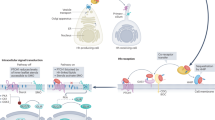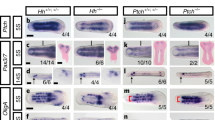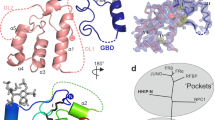Abstract
The Hedgehog signalling pathway is essential for the development of diverse tissues during embryogenesis1. Signalling is activated by binding of Hedgehog protein to the multipass membrane protein Patched (Ptc)2,3. We have now identified a novel component in the vertebrate signalling pathway, which we name Hip (for Hedgehog-interacting protein) because of its ability to bind Hedgehog proteins. Hip encodes a membrane glycoprotein that binds to all three mammalian Hedgehog proteins with an affinity comparable to that of Ptc-1. Hip-expressing cells are located next to cells that express each Hedgehog gene. Hip expression is induced by ectopic Hedgehog signalling and is lost in Hedgehog mutants. Thus, Hip, like Ptc-1, is a general transcriptional target of Hedgehog signalling. Overexpression of Hip in cartilage, where Indian hedgehog (Ihh) controls growth4, leads to a shortened skeleton that resembles that seen when Ihh function is lost (B. St-Jacques, M. Hammerschmidt & A.P.M., in preparation). Our findings support a model in which Hip attenuates Hedgehog signalling as a result of binding to Hedgehog proteins: a negative regulatory feedback loop established in this way could thus modulate the responses to any Hedgehog signal.
This is a preview of subscription content, access via your institution
Access options
Subscribe to this journal
Receive 51 print issues and online access
$199.00 per year
only $3.90 per issue
Buy this article
- Purchase on Springer Link
- Instant access to full article PDF
Prices may be subject to local taxes which are calculated during checkout





Similar content being viewed by others
References
Hammerschmidt, M., Brook, A. & McMahon, A. P. The world according to hedgehog. Trends Genet. 13, 14–21 (1997).
Tabin, C. J. & McMahon, A. P. Recent advances in Hedgehog signaling. Trends Cell Biol. 7, 442–446 (1997).
Ingham, P. W. Transducing Hedgehog: the story so far. EMBO J. 17, 3505–3511 (1998).
Vortkamp, A. et al. Regulation of rate of cartilage differentiation by Indian hedgehog and PTH-related protein. Science 273, 613–622 (1996).
Jessell, T. M. & Dodd, J. Floor plate-derived signals and the control of neural cell pattern in vertebrates. Harvey Lect. 86, 87–128 (1990).
Schwabe, J. W. R., Rodriguez-Esteban, C. & Izpisua Belmonte, J. C. Limbs are moving: where are they going? Trends Genet. 14, 229–235 (1998).
Bitgood, M. J. & McMahon, A. P. Hedgehog and Bmp genes are coexpressed at many diverse sites of cell-cell interaction in the mouse embryo. Dev. Biol. 172, 126–138 (1995).
Bitgood, M. J., Shen, L. & McMahon, A. P. Sertoli cell signaling by Desert hedgehog regulates the male germline. Curr. Biol. 6, 298–304 (1996).
Porter, J. A. et al. Hedgehog patterning activity: role of a lipophilic modification mediated by the carboxy-terminal autoprocessing domain. Cell 86, 21–34 (1996).
Chen, Y. & Struhl, G. Dual roles for patched in sequestering and transducing Hedgehog. Cell 87, 553–563 (1996).
Cheng, H. J. & Flanagan, J. G. Identification and cloning of ELF-1, a developmentally expressed ligand for the Mek4 and Sek receptor tyrosine kinases. Cell 79, 157–168 (1994).
Yang, Y. et al. Relationship between dose, distance and time in Sonic Hedgehog-mediated regulation of anteroposterior polarity in the chick limb. Development 124, 4393–4404 (1997).
von Heijne, G. Protein targeting signals. Curr. Opin. Cell Biol. 2, 604–608 (1990).
Muskavitch, M. A. & Hoffmann, F. M. Homologs of vertebrate growth factors in Drosophila melanogaster and other invertebrates. Curr. Top. Dev. Biol. 24, 289–328 (1990).
Brown, D. D. et al. The thyroid hormone-induced tail resorption program during Xenopus laevis metamorphosis. Proc. Natl Acad. Sci. USA 93, 1924–1929 (1996).
Schneider, D., Bruton, C. J. & Chater, K. F. Characterization of spaA, a Streptomyces coelicolor gene homologous to a gene involved in sensing starvation in Escherichia coli. Gene 177, 243–251 (1996).
Sanicola, M. et al. Glial cell line-derived neurotrophic factor-dependent RET activation can be mediated by two different cell-surface accessory proteins. Proc. Natl Acad. Sci. USA 94, 6238–6243 (1997).
Matlack, K. E., Mothes, W. & Rapoport, T. A. Protein translocation: tunnel vision. Cell 92, 381–390 (1998).
Stone, D. M. et al. The tumour-suppressor gene patched encodes a candidate receptor for Sonic hedgehog. Nature 384, 129–134 (1996).
Marigo, V., Davey, R. A., Zuo, Y., Cunningham, J. M. & Tabin, C. J. Biochemical evidence that Patched is the Hedgehog receptor. Nature 384, 176–179 (1996).
Echelard, Y. et al. Sonic hedgehog, a member of a family of putative signaling molecules, is implicated in the regulation of CNS polarity. Cell 75, 1417–1430 (1993).
Goodrich, L. V., Johnson, R. L., Milenkovic, L., McMahon, J. A. & Scott, M. P. Conservation of the hedgehog/patched signaling pathway from flies to mice: induction of a mouse patched gene by Hedgehog. Genes Dev. 10, 301–312 (1996).
Epstein, D. J., Marti, E., Scott, M. P. & McMahon, A. P. Antagonizing cAMP-dependent protein kinase A in the dorsal CNS activates a conserved Sonic hedgehog signaling pathway. Development 122, 2885–2894 (1996).
Nakata, K. et al. Osteoarthritis associated with mild chondrodysplasia in transgenic mice expressing alpha 1(IX) collagen chains with a central deletion. Proc. Natl Acad. Sci. USA 90, 2870–2874 (1993).
Cheah, K. S., Lau, E. T., Au, P. K. & Tam, P. P. Expression of the mouse alpha 1(II) collagen gene is not restricted to cartilage during development. Development 111, 945–953 (1991).
Sambrook, J., Fritsch, E. F. & Maniatis, T. Molecular Cloning: A Laboratory Manual (Cold Spring Harbor Laboratory Press, New York, (1989)).
Hirokawa, T., Boon-Chieng, S. & Mitaku, S. SOSUI: classification and secondary structure prediction system for membrane proteins. Bioinformatics 14, 378–379 (1998).
Wilkinson, D. G. & Nieto, M. A. Detection of messenger RNA by in situ hybridization to tissue sections and whole mounts. Methods Enzymol. 225, 361–373 (1993).
Hogan, B., Beddington, R., Costantini, F. & Lacy, E. Manipulating the Mouse Embryo: A Laboratory Manual (Cold Spring Harbor Laboratory Press, New York, (1994)).
Acknowledgements
We thank H.-J. Cheng for advice on expression cloning, J.-L. Chen for help with sequencing, B. St-Jacques for Ihh mutant embryos, S. Lee, J. McMahon and M. Bitgood for performing in situ hybridization, N. Wu for pronuclear injection, D. Faria and B. Klumpar for histological section, M. Scott for the Patched-1 expression clone, B. Seed for pCD5IgG1 vector, Y. Yamada for the α1(II) collagen expression vector and M. Sanicola for the RETL1 clone, anti-RETL1 antibody and a protocol for PI–PLC cleavage. We thank past and present members of the McMahon lab for discussion and critical reading of the manuscript. P.-T.C. is a fellow of the Leukemia Society of America. This work was supported by a grant from the NINDS to A.P.M. The GenBank accession number for Hip is AF116865.
Author information
Authors and Affiliations
Rights and permissions
About this article
Cite this article
Chuang, PT., McMahon, A. Vertebrate Hedgehog signalling modulated by induction of a Hedgehog-binding protein. Nature 397, 617–621 (1999). https://doi.org/10.1038/17611
Received:
Accepted:
Issue Date:
DOI: https://doi.org/10.1038/17611
This article is cited by
-
Hedgehog signaling in tissue homeostasis, cancers, and targeted therapies
Signal Transduction and Targeted Therapy (2023)
-
Hedgehog interacting protein activates sodium–glucose cotransporter 2 expression and promotes renal tubular epithelial cell senescence in a mouse model of type 1 diabetes
Diabetologia (2023)
-
A topographic atlas defines developmental origins of cell heterogeneity in the human embryonic lung
Nature Cell Biology (2023)
-
Hedgehog signaling and its molecular perspective with cholesterol: a comprehensive review
Cellular and Molecular Life Sciences (2022)
-
Deciphering and reconstitution of positional information in the human brain development
Cell Regeneration (2021)
Comments
By submitting a comment you agree to abide by our Terms and Community Guidelines. If you find something abusive or that does not comply with our terms or guidelines please flag it as inappropriate.



